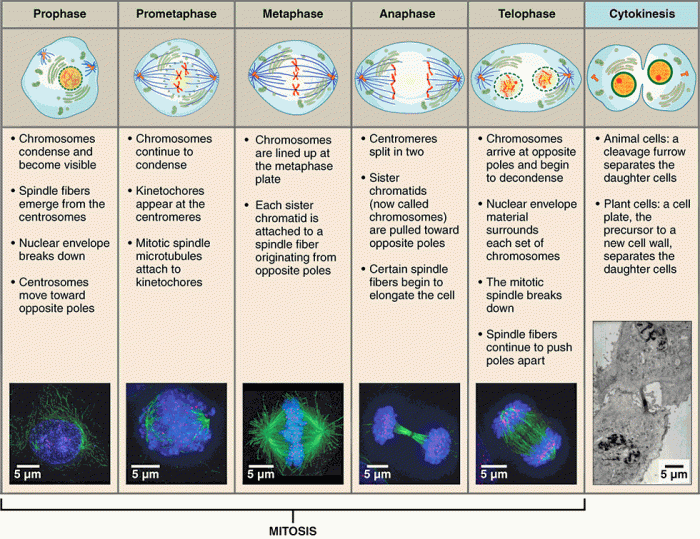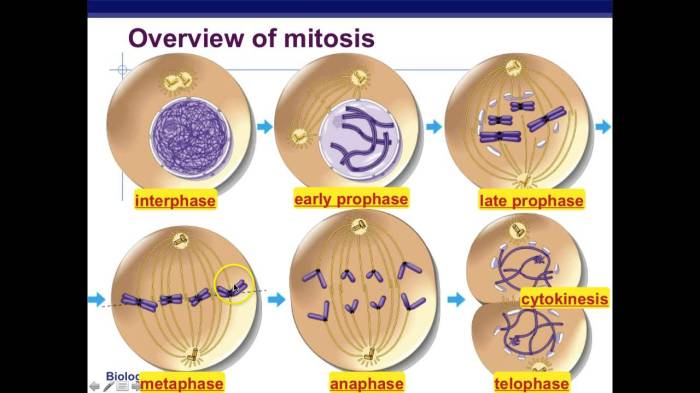Embark on a captivating journey into the realm of cell division with our comprehensive Cell Division Examining Mitosis Lab. Prepare to unravel the intricate mechanisms that govern cellular reproduction, unlocking the secrets of life’s fundamental processes.
Through hands-on exploration and expert guidance, we delve into the fascinating world of mitosis, the process by which cells divide and replicate their genetic material. Witness the dynamic choreography of chromosomes, spindle fibers, and other cellular components as they orchestrate the precise duplication of DNA.
Introduction

Cell division is a fundamental process in all living organisms, allowing for growth, repair, and reproduction. Mitosis, a specific type of cell division, ensures the equal distribution of genetic material to daughter cells. This lab aims to examine the stages of mitosis and its significance in maintaining the health and proper functioning of organisms.
Materials and Methods
Materials:
- Microscopes
- Slides
- Prepared specimens (e.g., onion root tips, whitefish blastula)
- Staining reagents (e.g., acetocarmine, methylene blue)
Procedure:
- Prepare slides by placing a drop of the specimen onto a slide and staining it.
- Observe the slides under a microscope using various magnifications.
- Identify and record the different stages of mitosis, including prophase, metaphase, anaphase, and telophase.
Results

Expected Observations:
| Stage | Description | Image |
|---|---|---|
| Prophase | Chromosomes condense and become visible. Spindle fibers form. | [Gambar prophase] |
| Metaphase | Chromosomes align at the metaphase plate. | [Gambar metaphase] |
| Anaphase | Sister chromatids separate and move to opposite poles. | [Gambar anaphase] |
| Telophase | Chromosomes reach the poles. Nuclear envelopes reform. | [Gambar telophase] |
Discussion

Significance of Mitosis:
- Growth: Mitosis allows for the production of new cells, contributing to the growth of organisms.
- Repair: Mitosis replaces damaged cells, maintaining tissue integrity.
- Reproduction: Mitosis is essential for asexual reproduction in some organisms.
Checkpoints:
Checkpoints ensure accurate cell division by monitoring the progression of mitosis. They prevent errors that could lead to aneuploidy or cancer.
Consequences of Errors:
- Aneuploidy: Errors in chromosome segregation can result in cells with an abnormal number of chromosomes.
- Cancer: Uncontrolled cell division, often caused by defects in mitosis, can lead to cancer.
Frequently Asked Questions: Cell Division Examining Mitosis Lab
What is the purpose of mitosis?
Mitosis is a type of cell division that produces two identical daughter cells from a single parent cell. It is essential for growth, repair, and reproduction in all living organisms.
What are the different stages of mitosis?
Mitosis consists of four main stages: prophase, metaphase, anaphase, and telophase. During these stages, the chromosomes condense, align, and divide, resulting in the formation of two new nuclei.
What is the role of checkpoints in mitosis?
Checkpoints are control mechanisms that ensure that mitosis proceeds accurately. They monitor the progress of mitosis and halt the process if any errors are detected.